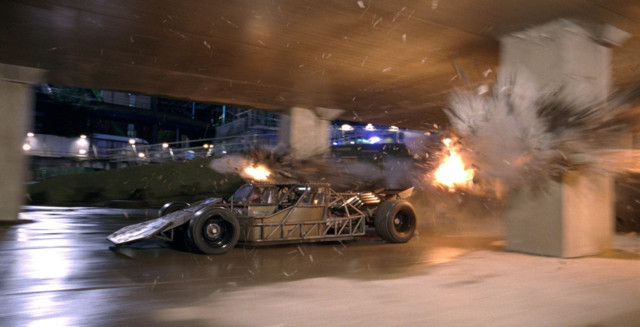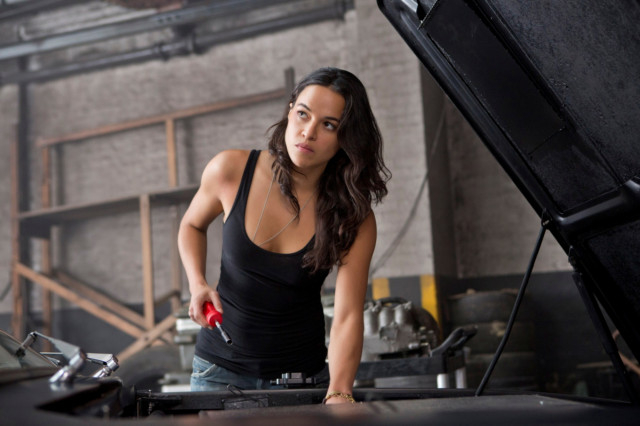
The idea came screeching into director Justin Lin’s fuel-injected imagination in 2009: a fiery escape scene featuring a muscle car that crashes out of an airplane during takeoff.
In production at the time on Fast & Furious – the fourth installment of the franchise that has grossed $1.6 billion in worldwide box office since 2001 – he commissioned digital “pre-visualisation” artists to mock up a rendering even though the stunt did not fit the movie he was making and was too expensive to film.
Two years on, the scene didn’t make the cut for Lin’s 2011 sequel Fast Five either. “The technology wasn’t ready yet, and I couldn’t find the right story to tell it in,” the director explained. “Everything’s limitless. But you have to make sure the sequence fits organically into the journey. I would never stick it into a movie just because it’s cool.”
Audiences can finally catch Lin’s explosive car deplanement this weekend with the release of Fast & Furious 6. Reprising his role as outlaw wheelman Dominic Toretto in the mega budget action-adventure, Vin Diesel can be seen smashing his Dodge Charger SRT8 through the nose of a Soviet-era cargo aircraft moments before the plane munches runway tarmac.
And that’s just one of nearly 20 such adrenaline-punched scenes in Fast 6, the latest edition of a franchise initially written off as “disposable cinema” before being resurrected to become one of Hollywood’s most reliably lucrative movie bets.
“’Fast & Furious’ became an adjective for neon lights and hot chicks or something,” Lin said. “I felt like we could create something different.”
In March, Lin was going full throttle, attempting to cram a year and a half’s worth of post-production into 12 weeks. The director had five film editors simultaneously cutting Fast 6 together while teams of specialists made visual effects and colour timing tweaks elsewhere on the lot. Sound mixing took up two movie-theatre-sized stages all by itself.
Standing before a bank of computer consoles and mixing monitors in one stage, sound designer Peter “Downtown” Brown tossed Lin a football. And the director attempted to throw an arcing spiral through a basketball hoop nearly 50 feet away.
“I only get to practice this every two years on these films,” Lin said sheepishly after his sixth clanger.
He’s had the keys to the franchise since being hired to direct 2006’s The Fast and the Furious: Tokyo Drift and has honed his football hoops game ever since. But Lin’s efficacy is better measured in the Fast films’ continuing box-office relevancy: The director persuaded Diesel – who bailed as marquee star after the first movie – to return to the driver’s seat for Fast & Furious (which grossed a robust $363 million worldwide) and effectively rebooted the series by de-emphasising the earlier films’ candy-colored street drag racing in favour of revving up character development.
“Vin’s a big Dungeons & Dragons guy, and we talked about what this franchise lacked: a mythology,” Lin said.
In an email, Diesel extolled his “creative partnership” with Lin. “He has risen to the occasion time and time again, proving to be a director with a style that takes action to the next level,” Diesel said.
Like previous Fast installments, the sixth movie follows the exploits of a mercenary band of speed demons (series regulars actor-singer Tyrese, actress-model Elsa Pataky, rapper-actor Ludacris, Sung Kang and Jordana Brewster among them) who are constitutionally incapable of driving 55.
Led by Diesel and Paul Walker’s ex-undercover cop character, the crew is recruited by government agent Luke Hobbs (Dwayne “The Rock” Johnson, reprising his character from Fast Five) and travels to London to attempt to corral a lethal criminal gang in exchange for full government pardons.
Things get complicated when the bad guys’ second in command is revealed to be none other than Letty, Dom’s old love interest (Michelle Rodriguez), who was left for dead in the fourth Fast film and is dead-set against returning to the Fast fold.
So much so, she pumps a bullet into her ex-beau for emphasis.
Fast 6 became just the third movie production permitted to film in the British capital’s Piccadilly Circus (where Dom’s Dodge Daytona and Letty’s vintage Jensen coupe can be seen drag racing among double-decker buses).
And the film features such high-tech eye candy as Formula One-inspired “flip cars” that function like fast-moving jump ramps – any London police cruisers unlucky enough to run into the vehicles unwillingly get the Dukes of Hazzard treatment.
Then there’s the chase sequence in which a criminal mastermind (Brit actor Luke Evans) commandeers a tank and proceeds to level roughly 250 cars on a Spanish highway.
According to producer Neal Moritz, the filmmakers originally intended to pump up the action in those scenes with computer-generated imagery but ended up orchestrating no small amount of real-time automotive mayhem.
“When you see the tank running into cars on the freeway, that’s real,” Moritz said. “The tank was running them over on this road in the Canary Islands.”
Despite the mounting pressure to deliver one of summer’s biggest tent-pole movies on time and within budget – Lin betrayed no signs of fatigue or stress. He contrasted his predicament against making Better Luck Tomorrow the indie crime-drama that opened at the Sundance Film Festival in 2002 and first put the director on Hollywood’s radar.
“When you have 10 credit cards and you’re $100,000 in debt with nobody believing in you or knowing if your film will ever be seen?” Lin said. “This is nothing compared to that.”













